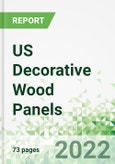Demand for decorative wood panels is projected to remain around 4.4 billion square feet, as measured on a 3/8-inch basis, through 2024, restricted by:
Although new home construction and residential renovation spending are expected to regress back toward 2019 levels near the end of the forecast period, losses will be offset as the commercial market begins to turn around from prolonged losses, particularly among such buildings as offices, healthcare facilities, and schools and universities, which are intensive users of decorative panels in cabinets and interior wall panels.
Other design trends, however, are having a moderating effect on decorative wood panel demand. The continued popularity of open floor plans is reducing the number of doors installed per home, and interior wood paneling remains relatively unfashionable as a wall covering, with homeowners instead turning to products such as wallpaper and tile to add interest to their wall spaces.
- a moderation in new home construction, as many products that utilize decorative panels - such as cabinets and siding - are installed during the construction process
- a decline in commercial building construction in the early part of the forecast period, as losses will not be recovered even after the market begins to rebound
- declining use of decorative wood panels in siding and doors
- Preventing declines in decorative wood panel demand will be an increase in their use in finish flooring applications as well as sustained demand for cabinets. Both markets will benefit in the short term from unexpected growth in residential construction, while finish flooring is expected to offer longer term gains due to continued design trends favoring use of hard surface flooring
Unexpected Interest in Residential Construction Sustains Decorative Wood Panel Demand
Decorative wood panel demand is concentrated in the residential market, where these products are commonly used in such applications as cabinets and finish flooring. Growth in both residential remodeling and new home construction in the second half of 2020 and into 2021 and 2022 helped prevent losses for these products throughout the pandemic.Although new home construction and residential renovation spending are expected to regress back toward 2019 levels near the end of the forecast period, losses will be offset as the commercial market begins to turn around from prolonged losses, particularly among such buildings as offices, healthcare facilities, and schools and universities, which are intensive users of decorative panels in cabinets and interior wall panels.
Finish Flooring Application a Bright Spot for Decorative Panels
While demand for decorative wood panels will remain flat or decline in most applications by 2024, finish flooring will be an exception, growing over this period. Gains will be driven by the rising use of flooring made from hardwood plywood because of its aesthetic and performance properties, which will lead consumers to specify it over less durable materials. Design trends are increasingly calling for use of hardwood and wood-look flooring throughout the home, including in rooms where carpet and tile once predominated.Other design trends, however, are having a moderating effect on decorative wood panel demand. The continued popularity of open floor plans is reducing the number of doors installed per home, and interior wood paneling remains relatively unfashionable as a wall covering, with homeowners instead turning to products such as wallpaper and tile to add interest to their wall spaces.
Table of Contents
1. Executive SummaryList of TablesList of Figures
2. About This Report
3. Overview
4. Applications
5. Industry Structure
6. Appendix
2. About This Report
3. Overview
4. Applications
5. Industry Structure
6. Appendix
1. Executive Summary
2. About This Report
3. Overview
4. Applications
6. Appendix








